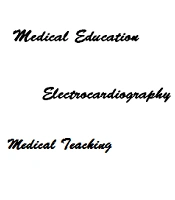Dear Editor,
The early diagnosis of cardiac arrhythmias is essential to detect patients at a high risk of cardiac arrest, and proper medical measures can be taken immediately after their correct diagnosis (1). An electrocardiogram (ECG) is a standard and excellent diagnostic test used to diagnose cardiac arrhythmias with high accuracy (2). The ECG is an easy-to-implement, low-cost, fast, and safe examination that provides health professionals with valuable information, making it a powerful diagnostic tool for patients’ health. According to the European Cardiovascular Association guidelines on the management of acute myocardial infarction patients (3), the interval between the first medical contact and recording of the first ECG is among the good indicators of care quality; it should not be longer than 10 minutes (4). Various studies have discussed the best teaching styles to improve ECG interpretation skills (5-8). The ECG interpretation is complicated and is performed by various health professionals, such as nurses, physicians, paramedics, and especially cardiologists (5). Numerous medical students have limited knowledge and self-confidence to interpret ECGs (1). However, there is a concern that nursing and medical students worldwide lack the confidence and competence to interpret and analyze ECGs (9).
Clinical training is one of the most important aspects of medical education. Improving ECG interpretation skills by nursing students and emphasizing the achievement of a higher level of clinical competence in cardiac disease diagnosis is the most important purpose of clinical training, specifically in emergency and cardiac wards (10, 11). The ECG devices generally present a fixed cardiac lead sequence. Medical and nursing students face various diagnoses in hospitals, and the order of lead arrangement plays a significant role in some of these diagnoses. For instance, the determination of the heart’s electrical axis and diagnosis of various cardiac blockages, cardiac arrests, hypertrophy in various areas of the heart, and pulmonary embolism require that cardiac leads be evaluated and observed in various groups, which could vary based on the diagnosis. Displaying a fixed cardiac lead sequence on an ECG or ECG paper requires the leads to be placed based on the assumed diagnosis of the students. The fixed order of leads requires time, reduces accuracy, and entails the interpreter to recall the learned materials to interpret ECG. Considering the significance of heart disease diagnosis accuracy and the fact that there is a golden time for diagnosis and treatment procedures in such patients, it is recommended to add options for various cardiac lead arrangements ECG devices according to different diagnoses.
In this regard, an interventional study was performed in which a group of Chinese interns was provided with ECGs with routine lead arrangements based on the device’s default settings to determine the heart axis; however, the other group was provided with ECGs with suitable lead arrangements for heart axis determination. The results indicated that the interns who received ECGs with suitable lead arrangements for heart axis determination made more accurate diagnoses (8). The order of leads’ arrangement for various diagnoses could increase medical science students’ and even health professionals’ speed and accuracy. Upgrading ECG device settings by manufacturing companies could make effective strides toward the improvement of education quality and ECG interpretation skills in medical science universities.
